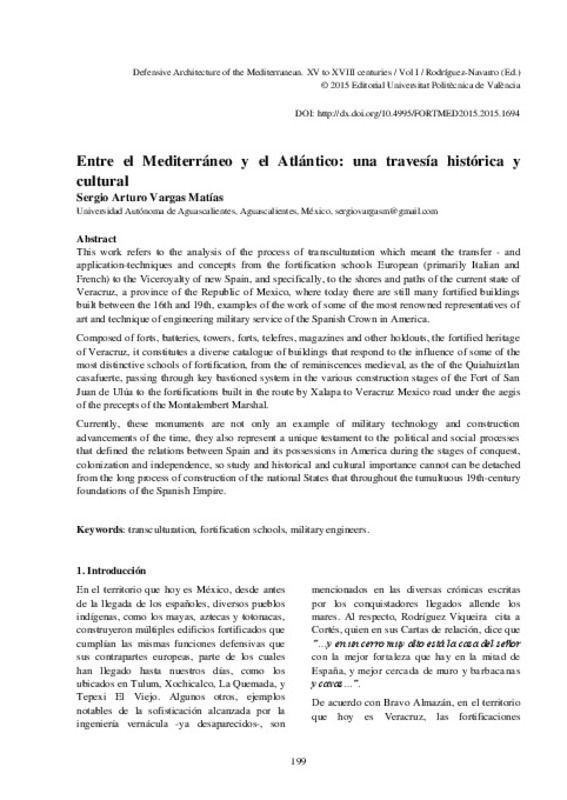JavaScript is disabled for your browser. Some features of this site may not work without it.
Buscar en RiuNet
Listar
Mi cuenta
Estadísticas
Ayuda RiuNet
Admin. UPV
Entre el Mediterráneo y el Atlántico: una travesía histórica y cultural
Mostrar el registro sencillo del ítem
Ficheros en el ítem
| dc.contributor.author | Vargas Matías, Sergio Arturo
|
es_ES |
| dc.date.accessioned | 2018-01-17T10:35:24Z | |
| dc.date.available | 2018-01-17T10:35:24Z | |
| dc.date.issued | 2015-10-16 | |
| dc.identifier.isbn | 9788490483770 | |
| dc.identifier.uri | http://hdl.handle.net/10251/94993 | |
| dc.description.abstract | [EN] This work refers to the analysis of the process of transculturation which meant the transfer - and application-techniques and concepts from the fortification schools European (primarily Italian and French) to the Viceroyalty of new Spain, and specifically, to the shores and paths of the current state of Veracruz, a province of the Republic of Mexico, where today there are still many fortified buildings built between the 16th and 19th, examples of the work of some of the most renowned representatives of art and technique of engineering military service of the Spanish Crown in America. Composed of forts, batteries, towers, forts, telefres, magazines and other holdouts, the fortified heritage of Veracruz, it constitutes a diverse catalogue of buildings that respond to the influence of some of the most distinctive schools of fortification, from the of reminiscences medieval, as the of the Quiahuiztlan casafuerte, passing through key bastioned system in the various construction stages of the Fort of San Juan de Ulúa to the fortifications built in the route by Xalapa to Veracruz Mexico road under the aegis of the precepts of the Montalembert Marshal. Currently, these monuments are not only an example of military technology and construction advancements of the time, they also represent a unique testament to the political and social processes that defined the relations between Spain and its possessions in America during the stages of conquest, colonization and independence, so study and historical and cultural importance cannot can be detached from the long process of construction of the national States that throughout the tumultuous 19th-century foundations of the Spanish Empire. | es_ES |
| dc.format.extent | 8 | es_ES |
| dc.language | Español | es_ES |
| dc.publisher | Editorial Universitat Politècnica de València | es_ES |
| dc.relation.ispartof | Defensive architecture of the mediterranean: XV to XVIII centuries. Vol. I | es_ES |
| dc.rights | Reconocimiento - No comercial - Sin obra derivada (by-nc-nd) | es_ES |
| dc.subject | Fortifications | es_ES |
| dc.subject | Mediterranean | es_ES |
| dc.subject | Modern age | es_ES |
| dc.subject | Built Heritage | es_ES |
| dc.subject | Transculturation | es_ES |
| dc.subject | Fortification schools | es_ES |
| dc.subject | Military engineers | es_ES |
| dc.title | Entre el Mediterráneo y el Atlántico: una travesía histórica y cultural | es_ES |
| dc.type | Capítulo de libro | es_ES |
| dc.type | Comunicación en congreso | es_ES |
| dc.identifier.doi | 10.4995/FORTMED2015.2015.1694 | |
| dc.rights.accessRights | Abierto | es_ES |
| dc.description.bibliographicCitation | Vargas Matías, SA. (2015). Entre el Mediterráneo y el Atlántico: una travesía histórica y cultural. En Defensive architecture of the mediterranean: XV to XVIII centuries. Vol. I. Editorial Universitat Politècnica de València. 199-206. https://doi.org/10.4995/FORTMED2015.2015.1694 | es_ES |
| dc.description.accrualMethod | OCS | es_ES |
| dc.relation.conferencename | FORTMED2015 - International Conference on Modern Age Fortifications of the Western Mediterranean coast | es_ES |
| dc.relation.conferencedate | October 15-17,2015 | es_ES |
| dc.relation.conferenceplace | Valencia, Spain | es_ES |
| dc.relation.publisherversion | http://ocs.editorial.upv.es/index.php/FORTMED/FORTMED2015/paper/view/1694 | es_ES |
| dc.description.upvformatpinicio | 199 | es_ES |
| dc.description.upvformatpfin | 206 | es_ES |
| dc.type.version | info:eu-repo/semantics/publishedVersion | es_ES |
| dc.relation.pasarela | OCS\1694 | es_ES |








